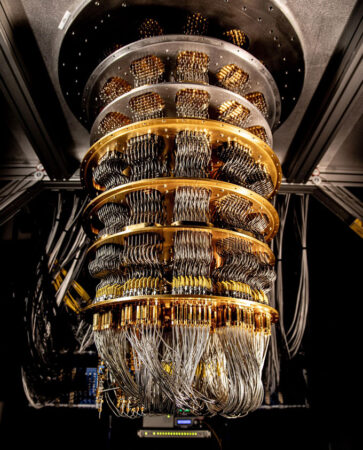Google’s quantum computer reached an error-correcting milestone
To shrink error rates in quantum computers, sometimes more is better. More qubits, that is.
The quantum bits, or qubits, that make up a quantum computer are prone to mistakes that could render a calculation useless if not corrected. To reduce that error rate, scientists aim to build a computer that can correct its own errors. Such a machine would combine the powers of multiple fallible qubits into one improved qubit, called a “logical qubit,” that can be used to make calculations (SN: 6/22/20).
Scientists now have demonstrated a key milestone in quantum error correction. Scaling up the number of qubits in a logical qubit can make it less error-prone, researchers at Google report February 22 in Nature.
Future quantum computers could solve problems impossible for even the most powerful traditional computers (SN: 6/29/17). To build those mighty quantum machines, researchers agree that they’ll need to use error correction to dramatically shrink error rates. While scientists have previously demonstrated that they can detect and correct simple errors in small-scale quantum computers, error correction is still in its early stages (SN: 10/4/21).
The new advance doesn’t mean researchers are ready to build a fully error-corrected quantum computer, “however, it does demonstrate that it is indeed possible, that error correction fundamentally works,” physicist Julian Kelly of Google Quantum AI said in a news briefing February 21.

Logical qubits store information redundantly in multiple physical qubits. That redundancy allows a quantum computer to check if any mistakes have cropped up and fix them on the fly. Ideally, the larger the logical qubit, the smaller the error rate should be. But if the original qubits are too faulty, adding in more of them will cause more problems than it solves.
Using Google’s Sycamore quantum chip, the researchers studied two different sizes of logical qubits, one consisting of 17 qubits and the other of 49 qubits. After making steady improvements to the performance of the original physical qubits that make up the device, the researchers tallied up the errors that still slipped through. The larger logical qubit had a lower error rate, about 2.9 percent per round of error correction, compared to the smaller logical qubit’s rate of about 3.0 percent, the researchers found.
Subscribe to Science News
Get great science journalism, from the most trusted source, delivered to your doorstep.
That small improvement suggests scientists are finally tiptoeing into the regime where error correction can begin to squelch errors by scaling up. “It’s a major goal to achieve,” says physicist Andreas Wallraff of ETH Zurich, who was not involved with the research.
However, the result is only on the cusp of showing that error correction improves as scientists scale up. A computer simulation of the quantum computer’s performance suggests that, if the logical qubit’s size were increased even more, its error rate would actually get worse. Additional improvement to the original faulty qubits will be needed to enable scientists to really capitalize on the benefits of error correction.
Still, milestones in quantum computation are so difficult to achieve that they’re treated like pole jumping, Wallraff says. You just aim to barely clear the bar.
For all the latest Technology News Click Here
For the latest news and updates, follow us on Google News.
